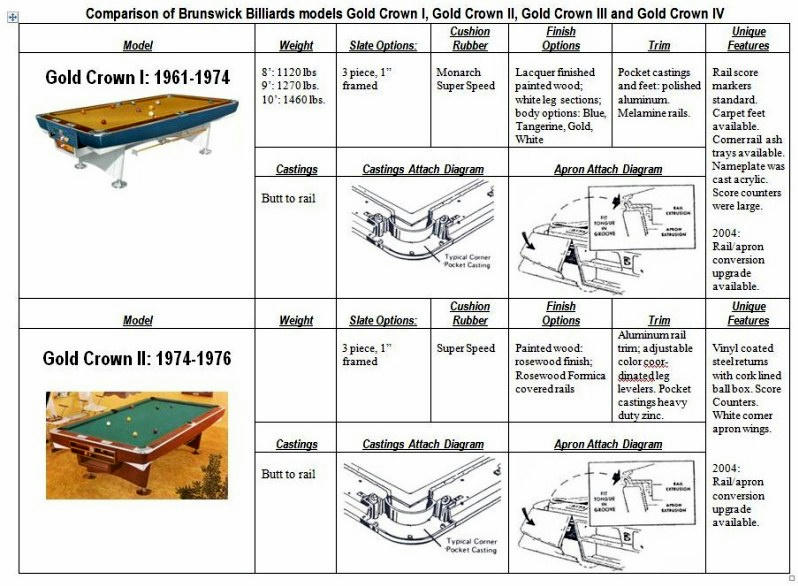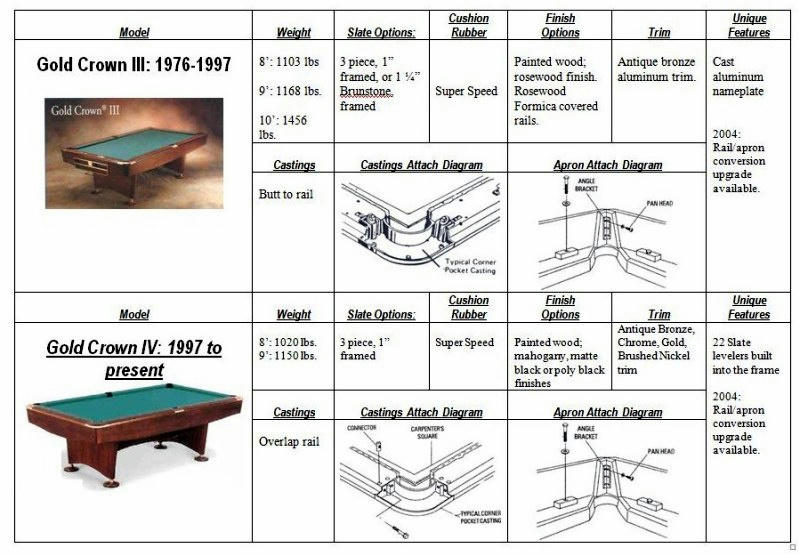You are using an out of date browser. It may not display this or other websites correctly.
You should upgrade or use an alternative browser.
You should upgrade or use an alternative browser.
Identifyong Gold Crowns
- Thread starter hdgis1
- Start date
How does one distinguish a GC1 from a GC2 or 3, etc. What characteristics should one keep an eye open for? Thanks all!
http://www.mediafire.com/pooltablemanuals
courtesy of Markuster
I just collected this stuff and put it all in one place. Most of it I found thru this forum. Here's the Gold Crown comparison chart (again)


Markus
What does that chart mean by rail/apron conversion upgrade?
If you look at the underside of a rail you can quickly tell if its a GC1 or not. If it has a big nut plate in the shape of a 8 for the rail bolts it is a GC1 they didn't start the floating nut plate in the rail until GC2.
If you look at the underside of a rail you can quickly tell if its a GC1 or not. If it has a big nut plate in the shape of a 8 for the rail bolts it is a GC1 they didn't start the floating nut plate in the rail until GC2.
1967 Gold Crown 1 had the captured nuts inside the rails. Up to 1966 they had the figure 8 plates. If you have a plastic Brunswick name plate in the head rail they usually have the figure 8 plates in the rails. The metal name plates usually have the captured nut. Both are still Gold Crown 1.
The real Gold Crown two was a factory mahogany finish on the aprons rather than a painted finish.
Jay
What does that chart mean by rail/apron conversion upgrade?
That's when the started selling the rail/apron kits to upgrade a GC1-3 to a GC4
I know it's an old thread, but I found this post informative.1967 Gold Crown 1 had the captured nuts inside the rails. Up to 1966 they had the figure 8 plates. If you have a plastic Brunswick name plate in the head rail they usually have the figure 8 plates in the rails. The metal name plates usually have the captured nut. Both are still Gold Crown 1.
The real Gold Crown two was a factory mahogany finish on the aprons rather than a painted finish.
Jay
I have a Gold Crown I, and I just took a rail off for the first time. I found corner castings with dates of September, 1962, and rails with captive nut plates, i.e., not the round or figure eight nut plates. The nut plates are inserted into slots that run perpendicular to the length of the rail, i.e., not lengthwise.
The nut plates for the cornner castings are bent, steel "T"-shaped plates, as I presume the earliest GC I's had.
So, a '67+ GC I with corners made much earlier, or perhaps replaced? I was told the table was refurbished, and the castings and feet have a beautiful satin-chrome finish, so it's possible they are not original.
lgherb
Registered
I finally had my GC re-assembled a few weeks ago. The corner castings had a date mark of June 12, 1963. That is the only verifiable date for my table.I know it's an old thread, but I found this post informative.
I have a Gold Crown I, and I just took a rail off for the first time. I found corner castings with dates of September, 1962, and rails with captive nut plates, i.e., not the round or figure eight nut plates. The nut plates are inserted into slots that run perpendicular to the length of the rail, i.e., not lengthwise.
The nut plates for the cornner castings are bent, steel "T"-shaped plates, as I presume the earliest GC I's had.
So, a '67+ GC I with corners made much earlier, or perhaps replaced? I was told the table was refurbished, and the castings and feet have a beautiful satin-chrome finish, so it's possible they are not original.
I'm guessing that over the years if any repair parts were needed they might have come from Brunswick's current production model at the time and not 'series appropriate'.
I won't worry that it might be a "Frankencrown" and just enjoy the table.
I've been grooving on it almost nightly to the point my guitar is worried I might be cheating on it. Lol.
That's the date they made the mold that was used for many years and does not indicate the date the castings were poured. Brunswick did not date code any of the parts.I finally had my GC re-assembled a few weeks ago. The corner castings had a date mark of June 12, 1963. That is the only verifiable date for my table.
I'm guessing that over the years if any repair parts were needed they might have come from Brunswick's current production model at the time and not 'series appropriate'.
I won't worry that it might be a "Frankencrown" and just enjoy the table.
I've been grooving on it almost nightly to the point my guitar is worried I might be cheating on it. Lol.
I'm not so sure of that. The two castings I have examined had different dates of 9-14-62 and 9-24-62. Having done some sand casting myself, I can say with virtual certainty that these dates were scratched into the sand with a scribe by the moulder as he was casting the item, after he removed the pattern from the sand. You can see that what appears to be a part number is the same for both, "E74263." Note the part number, which is part of the pattern, is very neat block text. The part number is coming off the pattern, the date is scratched in.That's the date they made the mold that was used for many years and does not indicate the date the castings were poured. Brunswick did not date code any of the parts.
lgherb
Registered
Don't those dates represent the date the casting was made and not the date the table was assembled? The dates on the casting from my table I looked at had a similar "hand written" quality to it.That's the date the mold was made.
If these were sand castings, those castings last for one pour and are done, right?
Based on what? Do you have any evidence to back that up?That's the date the mold was made.
That assertion is ridiculous. You're saying, for example, they made a mold on 9/14/62, and then made another one on 9/24/62. And, despite other numbers on the casting being made with machine-made numbers, they decide to put the date of the mold in scratchy, hand-made numerals?
It's not a mold, by the way, it's a pattern, these were sand-casted pieces.
How many castings can be made from one sand-cast? That date has NOTHING to do with when the table was built.Based on what? Do you have any evidence to back that up?
That assertion is ridiculous. You're saying, for example, they made a mold on 9/14/62, and then made another one on 9/24/62. And, despite other numbers on the casting being made with machine-made numbers, they decide to put the date of the mold in scratchy, hand-made numerals?
It's not a mold, by the way, it's a pattern, these were sand-casted pieces.
One.How many castings can be made from one sand-cast?
Agreed. But it's the exact date that the casting was made. The only thing that is certain about the table is that it was made after that date.That date has NOTHING to do with when the table was built.
You can d some research on sand casting. The thing that allows the repetition is called a pattern. It's usually made from hardwood, and pattern makers were at the top of the trade of professional wood workers. I even have a set of shrinkage scales, i.e., scales that are scaled to the shrinkage of various casting materials, used when one makes a pattern, so when the metal cools it's of the correct dimensions.
These GC castings are obviously sand castings. Not cleat is whether Brunswick did them in-house or subbed them out.
These GC castings are obviously sand castings. Not cleat is whether Brunswick did them in-house or subbed them out.